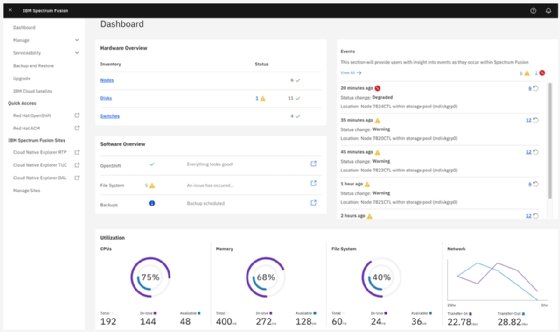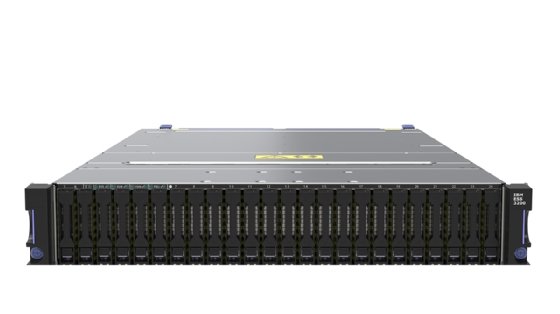
adimas - Fotolia
New IBM Spectrum Fusion storage takes aim at container users
IBM introduces Spectrum Fusion to target enterprises in container environments that span data center, edge and hybrid cloud environments.
IBM is directing its focus to enterprises working in container environments with a new Spectrum Fusion software-defined storage product that combines its general parallel file system, metadata management and data protection technologies.
The first Spectrum Fusion release, due in the second half of the year, will integrate compute, storage and networking into a hyper-converged infrastructure (HCI) system that comes equipped with the Red Hat OpenShift Kubernetes application platform. IBM has been tailoring products for use with Red Hat software since completing its $34 billion acquisition of the open source software vendor in July 2019.
Spectrum Fusion merges elements of three IBM software-defined products: Spectrum Scale's General Parallel File System (GPFS) than can span edge to core to cloud deployments, Spectrum Discover to catalog and index metadata, and Spectrum Protect Plus for backup-and-restore capabilities. Fusion also supports S3-based object storage on premises or in the cloud. Customers manage Spectrum Fusion through a single management portal.
IBM plans to release a software-only version of Spectrum Fusion in early 2022 for use on any server hardware on premises or in the public cloud. Clouds supported out of the gate will be AWS, Microsoft Azure, Google Cloud and IBM Cloud.

Addresses cloud-native workloads
"With Spectrum Fusion, IBM is creating a data platform specifically to address the needs of cloud-native workloads," said Scott Sinclair, a senior analyst at Enterprise Strategy Group, a division of TechTarget. "It's more than just a storage platform, or even traditional HCI. Leveraging Red Hat OpenShift, IBM is looking to dramatically simplify managing cloud-native application environments across the hybrid cloud."
Sinclair said Spectrum Fusion would accelerate access to system resources across a hybrid cloud ecosystem, and in turn, speed application development, and ultimately help IT infrastructure and operations teams, as well as developers. He expects the Fusion HCI system to generate significant interest with its simplified deployment model.
Spectrum Fusion follows an IBM pattern of giving customers the choice of buying software-only versions of storage products, as well as hardware configurations that bundle it. For instance, IBM's Elastic Storage System (ESS) builds in Spectrum Scale, which is also sold as a separately software-defined storage product.
Eric Herzog, vice president of business development and go-to-market in the IBM storage division, said Spectrum Fusion HCI would come out before the software-only option because of the large market opportunity, based on feedback the company received from customers and analysts. IBM also saw a gap with competitors that lead with virtual machines, rather than container-native deployments, Herzog said.
"We want to go to where the puck is going, and the world is moving to containers," Herzog said. "We will obviously support virtual machines as well. But we'll lead with container-native."

Enterprise shift to container-based hybrid clouds
Randy Kerns, a senior strategist and analyst at Evaluator Group, estimated that two-thirds of enterprises will either deploy a new container-based hybrid cloud or try to make a cloud-native, container-based environment that their DevOps teams have already built "enterprise-capable" over the next three years. He said lots of developers took a "roll-your-own" approach, but enterprise IT organizations want to put a support infrastructure in place.
"They want a vendor that they know is going to be there five to 10 years from now," Kerns said. "And they don't want to have to go out and try and beat the bushes to find somebody with a very demanding skill set, which is what the issue is right now."
Kerns said IBM bought Red Hat because of the "land grab going on" for enterprises that are deploying container-based hybrid clouds, and the new Spectrum Fusion product would give IBM a more complete offering than most rivals. He sees SUSE's Rancher with Longhorn as the closest competitor. Others include Red Hat OpenShift with OpenShift Container Storage, VMware vSphere and Tanzu and Hewlett Packard's Ezmeral. Some vendors focus on storage for container-based applications, including Pure Storage's Portworx.
"Storage for container environments is a bit of a wild, wild West kind of a scenario because every vendor is pursuing a different strategy. [But] they're only [addressing] maybe part of the problem," said Ashish Nadkarni, a group vice president within IDC's worldwide infrastructure practice. "What IBM is saying is, 'Hey, we support OpenShift, and OpenShift itself is very comprehensive. We will be able to give you a full stack of data services for OpenShift. Spectrum Fusion will give you everything you need.' That's why it's a big deal."
Until Spectrum Fusion, IBM customers had to put together the various elements they need for their hybrid cloud workloads, such as AI or big data analytics, in "piecemeal" fashion, Herzog said. He said all the pieces would have been "container-enabled" or "container-ready," but not "container-native" as they will be now, with Spectrum Scale running in a container. Spectrum Fusion HCI, for instance, packages compute, storage and networking, as well as RedHat OpenShift, Kubernetes and RedHat's virtualization technology, Herzog noted.
IBM updates ESS
Also today, IBM updated its ESS product line with a new ESS 3200 model that claims to double the read performance of the ESS 3000 model that it will replace. The 3200 can deliver 80 GB per second of throughput per node and support up to eight ports of 200 Gbps InfiniBand or 100 Gbps Ethernet to reduce latency. NVMe flash capacity starts at 41 TB and can scale up to 367 TB per 2U node with the ESS 3200.
IBM also added a denser ESS 5000 option that offers a maximum capacity of 15.2 petabytes with nine disk enclosures. IBM said existing customers can update their systems with additional drive enclosures.
The ESS 3200 and ESS 5000 have containerized system software and support Red Hat OpenShift, the Kubernetes Container Storage Interface (CSI), CSI snapshots and clones, Red Hat Ansible, Windows, Linux and bare-metal deployments.
Carol Sliwa is a TechTarget senior writer covering storage arrays and drives, flash and memory technologies, and enterprise architecture.







